B) False
Correct Answer

verified
Correct Answer
verified
Multiple Choice
Figure 9-2
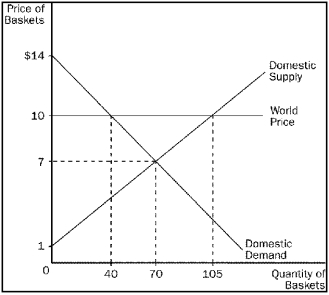 -Refer to Figure 9-2.With free trade,consumer surplus is
-Refer to Figure 9-2.With free trade,consumer surplus is
A) $45.
B) $80.
C) $210.
D) $245.
F) C) and D)
Correct Answer

verified
Correct Answer
verified
Multiple Choice
Figure 9-6
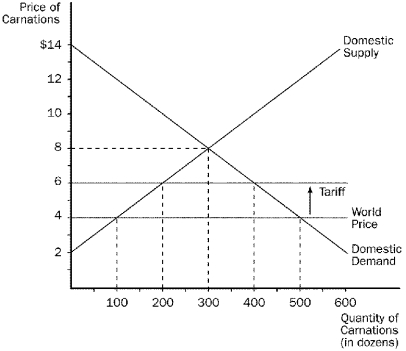 -Refer to Figure 9-6.When a tariff is imposed in the market,domestic producers
-Refer to Figure 9-6.When a tariff is imposed in the market,domestic producers
A) gain by $100.
B) gain by $200.
C) gain by $300.
D) lose by $100.
F) A) and C)
Correct Answer

verified
Correct Answer
verified
Multiple Choice
Opponents of free trade often want the United States to prohibit the import of goods made in overseas factories that pay wages below the U.S.minimum wage.Prohibiting such goods is likely to
A) cause these factories to pay the U.S. minimum wage.
B) increase the rate of technological advance in poor countries so that they can afford to pay higher wages.
C) increase poverty in poor countries and benefit U.S. firms which compete with these imports.
D) harm U.S. firms which compete with these imports.
F) A) and D)
Correct Answer

verified
Correct Answer
verified
True/False
"Trade raises the economic well-being of a nation in the sense that the gains of the winners exceed the losses of the losers." This statement is correct for a nation that exports manufactured goods,but it is not correct for a nation that imports manufactured goods.
B) False
Correct Answer

verified
Correct Answer
verified
Multiple Choice
Countries that restrict foreign trade are likely to
A) forgo the additional surplus that trade allows, but will probably enjoy economies of scale.
B) forgo the additional surplus that trade allows, but will be compensated by a higher rate of technological change.
C) forgo the additional surplus that trade allows, but will have a lower rate of unemployment.
D) have more firms with domestic market power.
F) None of the above
Correct Answer

verified
Correct Answer
verified
Multiple Choice
Figure 9-11
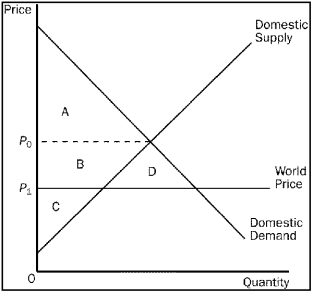 -Refer to Figure 9-11.Producer surplus in this market after trade is
-Refer to Figure 9-11.Producer surplus in this market after trade is
A) C.
B) C + B.
C) A + B + D.
D) B + C + D.
F) All of the above
Correct Answer

verified
Correct Answer
verified
True/False
For Country A,the world price of soybeans exceeds the domestic equilibrium price of soybeans.As a result,international trade allows buyers of soybeans in Country A to experience greater consumer surplus than they otherwise would experience.
B) False
Correct Answer

verified
Correct Answer
verified
Multiple Choice
Figure 9-11
 -Refer to Figure 9-11.Producer surplus plus consumer surplus in this market before trade is
-Refer to Figure 9-11.Producer surplus plus consumer surplus in this market before trade is
A) A + B.
B) A + B + C.
C) A + B + C + D.
D) B + C + D.
F) B) and C)
Correct Answer

verified
Correct Answer
verified
Multiple Choice
Suppose Ukraine subsidizes Ukrainian wheat farmers,while Russia offers no subsidy to Russian wheat farmers.As a result of the Ukrainian subsidy,sales of Ukrainian wheat to Russia
A) may prompt Russian farmers to invoke the infant-industry argument.
B) increase the consumer surplus of Russian buyers of wheat.
C) decrease the total surplus of the Russian people.
D) All of the above are correct.
F) C) and D)
Correct Answer

verified
Correct Answer
verified
Multiple Choice
Spain is an importer of computer chips,taking the world price of $12 per chip as given.Suppose Spain imposes a $5 tariff on chips.As a result,
A) Spanish consumers of chips and Spanish producers of chips both gain.
B) Spanish consumers of chips gain and Spanish producers of chips lose.
C) Spanish consumers of chips lose and Spanish producers of chips gain.
D) Spanish consumers of chips and Spanish producers of chips both lose.
F) None of the above
Correct Answer

verified
Correct Answer
verified
Multiple Choice
Figure 9-4. The domestic country is Nicaragua.
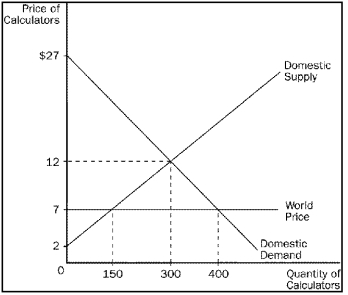 -Refer to Figure 9-4.Consumer surplus in Nicaragua without trade is
-Refer to Figure 9-4.Consumer surplus in Nicaragua without trade is
A) $375.
B) $2,000.
C) $2,250.
D) $8,700.
F) B) and C)
Correct Answer

verified
Correct Answer
verified
Multiple Choice
Figure 9-18. On the diagram below, Q represents the quantity of peaches and P represents the price of peaches. The domestic country is Isoland.
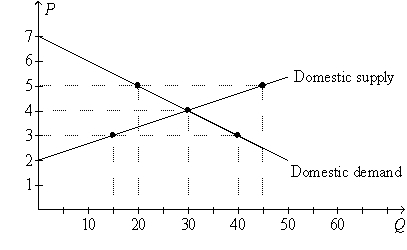 -Refer to Figure 9-18.Suppose Isoland changes from a no-trade policy to a policy that allows international trade.If the world price of peaches is $5,then the policy change results in a
-Refer to Figure 9-18.Suppose Isoland changes from a no-trade policy to a policy that allows international trade.If the world price of peaches is $5,then the policy change results in a
A) $25 decrease in consumer surplus.
B) $20 increase in consumer surplus.
C) $25 decrease in producer surplus.
D) $20 increase in producer surplus.
F) A) and D)
Correct Answer

verified
Correct Answer
verified
Multiple Choice
When the nation of Brownland first permitted trade with other nations,domestic producers of wheat experienced an increase in producer surplus of $4 million and total surplus in Brownland's wheat market increased by $1 million.We can conclude that
A) Brownland became an exporter of wheat.
B) consumer surplus in Brownland increased by $3 million.
C) the opening of trade caused the domestic supply curve for wheat in Brownland to shift to the left.
D) this example is inconsistent with the economic theory of international trade.
F) A) and C)
Correct Answer

verified
Correct Answer
verified
Multiple Choice
A country has a comparative advantage in a product if the world price is
A) lower than that country's domestic price without trade.
B) higher than that country's domestic price without trade.
C) equal to that country's domestic price without trade.
D) not subject to manipulation by organizations that govern international trade.
F) A) and C)
Correct Answer

verified
Correct Answer
verified
Multiple Choice
Which of the following is the most accurate statement?
A) The one argument for restricting trade that almost all economists accept as valid is the infant-industry argument.
B) Almost all economists insist that it is never appropriate to protect "key" industries, even when there are legitimate concerns about national security.
C) The idea that one nation might want to threaten another nation with a trade restriction is associated with the protection-as-a-bargaining-chip argument for restricting trade.
D) The protection-as-a-bargaining-chip argument for restricting trade is also known as the infant-industry argument.
F) A) and C)
Correct Answer

verified
Correct Answer
verified
Multiple Choice
When a country that imports a particular good imposes an import quota on that good,
A) producer surplus increases and total surplus increases in the market for that good.
B) producer surplus increases and total surplus decreases in the market for that good.
C) producer surplus decreases and total surplus increases in the market for that good.
D) producer surplus decreases and total surplus decreases in the market for that good.
F) A) and B)
Correct Answer

verified
Correct Answer
verified
Multiple Choice
When a country allows trade and becomes an importer of coal,
A) the losses of the domestic producers of coal exceed the gains of the domestic consumers of coal.
B) the losses of the domestic consumers of coal exceed the gains of the domestic producers of coal.
C) the gains of the domestic producers of coal exceed the losses of the domestic consumers of coal.
D) the gains of the domestic consumers of coal exceed the losses of the domestic producers of coal.
F) C) and D)
Correct Answer

verified
Correct Answer
verified
Multiple Choice
Honduras is an importer of goose-down pillows.The world price of these pillows is $50.Honduras imposes a $7 tariff on pillows.Honduras is a price-taker in the pillow market.As a result of the tariff,the price of goose-down pillows in Honduras
A) remains at $50 and the quantity of goose-down pillows purchased in Honduras decreases.
B) increases to $57 and the quantity of goose-down pillows purchased in Honduras decreases.
C) increases to a new price between $50 and $57 and the quantity of goose-down pillows purchased in Honduras decreases.
D) increases to a new price above $57 and the quantity of goose-down pillows purchased in Honduras remains the same.
F) B) and D)
Correct Answer

verified
Correct Answer
verified
Multiple Choice
Scenario 9-2
For a small country called Boxland, the equation of the domestic demand curve for cardboard is  where
where  represents the domestic quantity of cardboard demanded, in tons, and
represents the domestic quantity of cardboard demanded, in tons, and
 represents the price of a ton of cardboard.
For Boxland, the equation of the domestic supply curve for cardboard is
represents the price of a ton of cardboard.
For Boxland, the equation of the domestic supply curve for cardboard is  where
where  represents the domestic quantity of cardboard supplied, in tons, and
represents the domestic quantity of cardboard supplied, in tons, and  again represents the price of a ton of cardboard.
-Refer to Scenario 9-2.Suppose the world price of cardboard is $45.Then,relative to the no-trade situation,international trade in cardboard produces which of the following results for Boxland?
again represents the price of a ton of cardboard.
-Refer to Scenario 9-2.Suppose the world price of cardboard is $45.Then,relative to the no-trade situation,international trade in cardboard produces which of the following results for Boxland?
A) It increases consumer surplus, decreases producer surplus, and increases total surplus.
B) It increases consumer surplus, increases producer surplus, and increases total surplus.
C) It increases consumer surplus, decreases producer surplus, and decreases total surplus.
D) It decreases consumer surplus, increases producer surplus, and increases total surplus.
F) A) and B)
Correct Answer

verified
Correct Answer
verified
Showing 161 - 180 of 410
Related Exams